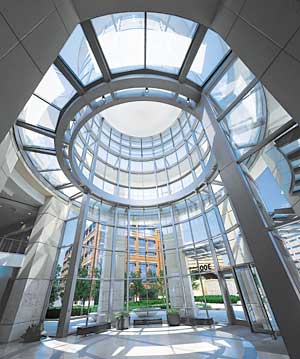21st Century Building Envelope Systems: Merging Innovation with Technology, Sustainability, and Function
Curtain Wall and Ribbon Window Systems
Architectural product manufacturers are increasingly developing systems comprised of compatible components that often provide many advantages. Another approach to this trend involves the use of curtain wall and ribbon window systems, utilizing aluminum fenestration. Curtain walls refer to a system that does not carry any dead load from the building other than its own weight. The loads are generally transferred to the main structure through connections at floors and building columns. Curtain walls are designed to resist air and water infiltration, and span multiple floors. Ribbon windows are horizontal architectural elements that are located around the building façade on a per floor basis.
"Building envelope systems must be designed with the goal of reduced field labor costs, greater thermal efficiency, and more flexibility for off-site assembly, sealing, and glazing. This will result in savings that can be passed on to building owners," says Greg Hall, Senior Product Development Designer, Vistawall Architectural Products, Terrell, Texas.
 |
| Curtain wall and window systems with excellent thermal performance
can lower energy costs and add natural daylight to public spaces. Photo credit: Vistawall |
A new high-performing pressure-equalized curtain wall system features exceptional water control, outstanding thermal performance, straightforward fabrication techniques, and easy installation. Several new related curtain wall framing systems share many common parts, such as gaskets, setting blocks, face members and anchors. This common chassis allows architects to combine two applications, curtain walls and ribbon windows, from a single system on the same building. These compatible parts allow easy transitions to occur between curtain wall and ribbon window details, design features, and construction installation. Use of common members and components between systems reduces construction errors and costs, and simplifies site fabrication.
Among the curtain wall and ribbon window systems, even more variations are available, such as a traditional pressure wall system, composite vertical mullion with traditional pressure wall horizontal members, and inside-glazed curtain wall, utilizing composite mullions throughout. These systems are typically available to meet a range of performance and thermal efficiency criteria. For maximum flexibility, these systems also share a common platform, the same glazing pocket design. This allows easier transitions from one system to another in the same project.
 |
| Curtain wall and ribbon window systems offer many component
variations to allow design flexibility and thermal efficiency. Photo credit: Vistawall |
Curtain wall systems that offer excellent thermal performance can provide lower energy costs to building owners and tenants, and add to a project's sustainability features.
Some new curtain wall systems utilize composite mullions, which offer several advantages. They include better thermal performance, decreased field labor due to factory-assembled one-piece design, and reduced glazing time due to elimination of screw-applied temporary glass retainers.
The inside-glazed version of the composite mullion curtain wall offers added benefits of glazing the system from inside the building. This feature eliminates the need for scaffolding, along with the safety risks and field installation costs, and further improves thermal performance. These curtain wall systems are suitable for projects in all climates, year round.
Flexibility of design options is another aspect that allows design professionals and specifiers to address finishes, sunshade systems, loading capabilities, horizontal mullions, and various tools for LEED® certification under the U.S. Green Building Council's LEED® Green Building Rating System.
A new ribbon window system provides a high level of thermal performance, and offers many accessories to accommodate various door framing and anchoring options. High performance criteria include levels of air infiltration, static water, deflection load, structural load, sound transmission class (STC), thermal performance, and testing results and certifications by recognized industry organizations, such at the National Fenestration Rating Council (NFRC).









